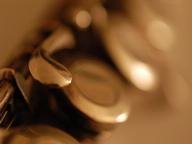Quiz Answer Key and Fun Facts
1. With which section of the orchestra does a saxophone sit?
2. One of the most famous saxophone parts in the orchestral repertoire is the solo in "The Old Castle" movement of Mussorgsky's "Pictures at an Exhibition". Whose orchestration of this work includes saxophone?
3. George Gershwin's music features saxophone fairly often. Which of the following of his works DOES NOT include a part for saxophone?
4. As well as Gershwin, numerous other American composers have included saxophone(s) in their orchestral compositions. Who of the following NEVER used saxophone?
5. Richard Strauss used saxophone(s) in one of his orchestral pieces. True or False?
6. Not surprisingly, the saxophone has been included in many orchestral works precisely due to its association with jazz. One seminal jazz-influenced work by Darius Milhaud features the saxophone very prominently. What is the name of this piece?
7. Perhaps surprisingly, Sergei Prokofiev included saxophone (usually a tenor) in several of his compositions. Which of the following Prokofiev pieces DOES NOT include a saxophone?
8. British composer Ralph Vaughan Williams included saxophone(s) in two of his symphonies. Which ones?
9. Sergei Rachmaninov NEVER included a saxophone in one of his orchestral compositions. True or False?
10. One of the very first composers to include saxophone in an orchestral work was Georges Bizet. Which of his compositions features saxophone?
Source: Author
MarcelMule
This quiz was reviewed by FunTrivia editor
ertrum before going online.
Any errors found in FunTrivia content are routinely corrected through our feedback system.

